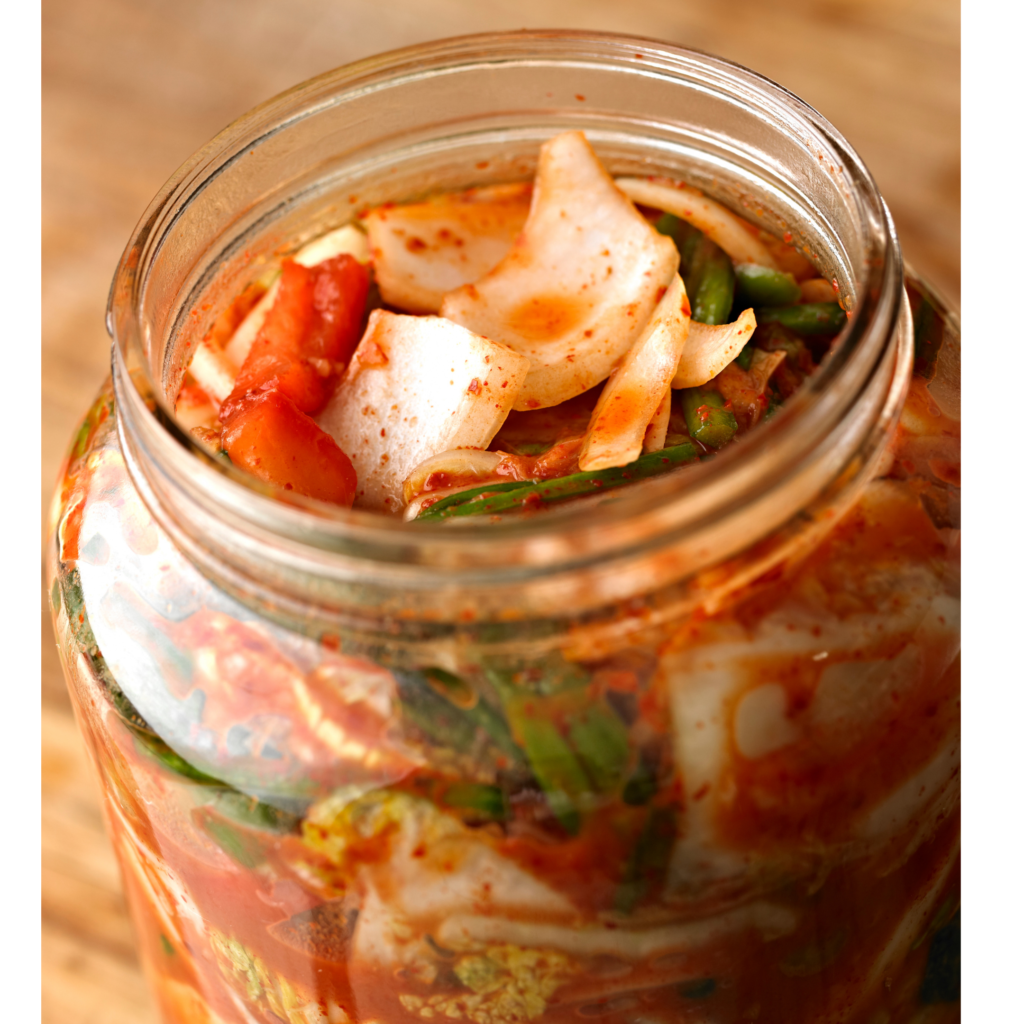[Traditional Korean Napa Cabbage Kimchi recipe adapted from my friend and colleague Torin Murphy]
*Makes 2-4 quarts
Ingredients:
- 2 Napa cabbages
- 2 cups gochucaru: hot pepper flakes (고춧가루) [make sure to get this from Korean store]
- About ½ cup salt
- 2 cups daikon radish (or similar)
- 2-3 carrots
- 7 to 8 green onions (scallions)
- 1 full head or about ½ cup garlic cloves (12-24 garlic cloves, to taste)
- 2 teaspoon fresh ginger, minced
- 1 medium onion, minced
- ½ cup fish sauce
- 2 cups water (dechlorinated/filtered)
- 2 tablespoons sweet rice flour (glutinous rice flour) [you may also grind the sweet/sticky rice to a powder if you don’t have the flour]
- 1 tablespoon raw white sugar (or coconut/alternative sugar)
- Utensils:
- Small saucepan
- Whisk
- Chef’s knife
- Cutting board
- Wooden spoon
- Rubber spatula
- Large bowl + mixing bowl
- 2-4 quart glass Mason jars
- Dechlorinated/filtered water for rinsing
- Optional: blender
Prep paste:
- In a small saucepan, combine the water and the rice flour, and sugar. Whisk to incorporate, then simmer over medium heat for about 10 minutes until it starts to thicken and bubble. Remove from the heat and let it cool to room temperature.
- Pour cooled porridge into a large mixing bowl, using a rubber spatula (to get all the goodness out!). Add the chili (gochu caru) powder, garlic, ginger, onion, fish sauce, Mix well with the wooden spoon until the mixture turns into a thin paste. (For finer paste texture, throw mixture into a blender for a quick grind, then transfer back into the same bowl using rubber spatula again).
Prep/salt the cabbage:
- Lightly trim off rough edge of cabbage cores, but do not remove, unless inedible
- Cut a shallow slit in the base of the cabbage core, then cut a perpendicular “X” slit the other way. You’ll then be able to get your fingers in there to pull the cabbage completely in half all the way through, without tearing the leaves. Then you can tear those halves into quarters from the slit going the other way.
- Rinse the quarters to make them wet.
- Thoroughly sprinkle salt between each leaf. Work from the base up in order to get a little on each leaf of the whole cabbage. Stems will take a little more salt to make them tender.
- Stack the cabbage into a large bowl and let them rest for 2 hours. Rotate the order every 30 minutes for even salt/water distribution.
- After 2 hours, thoroughly rinse cabbage quarters in cold, running water.
Make Kimchi:
- Prep the rest of the vegetables (radish, carrot, scallion) by washing.
- Lightly peel the radish and carrot (or scrape using brush, if organic).
- Chop the radish into radial flat circles, and chop into even matchsticks.
- Slice the carrots into thirds, then slice the long way to create a flat surface. Next chop perpendicularly into matchsticks.
- Chop the scallions into 1-inch diagonal strips.
- Incorporate the (matchstick) radish, carrot, and scallion into the paste, a handful at a time, until well mixed.
- Take the rinsed cabbage quarters, and roughly cut them every 1½” into pieces. Stir these pieces into the chile paste until thoroughly mixed.
- Pack into glass Mason jars. Makes anywhere from 2-4 quarts (depending on the size of your cabbages). Leave about 1 inch of air at the top of each jar, but ideally not more than about that.
- Using a clean towel or paper towel, wipe the jar from any escaped paste, and loosely cover with a clean lid.
- Let it age (unrefrigerated) overnight, 8-12 hours (and up to 24 hours depending on how fast it ferments at the temperature of your home – the hotter it is, the faster the fermentation), and then refrigerate. Burp the jars (by removing lid + stirring with clean utensil) before sticking in the fridge if necessary.
Enjoy it immediately, and also taste it every couple of days to see how the flavor develops as it ferments. This will also vary based on the temperature of the room.



